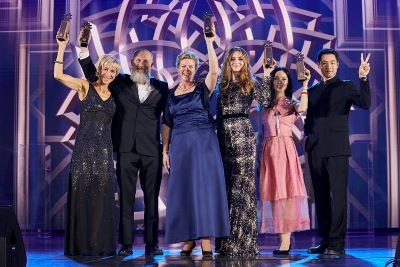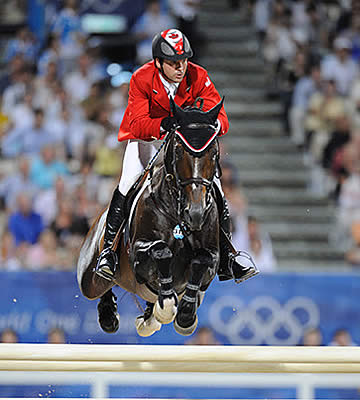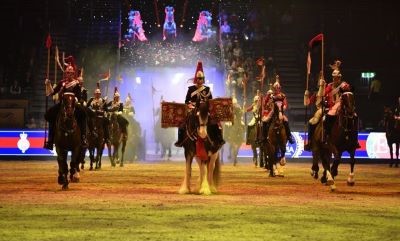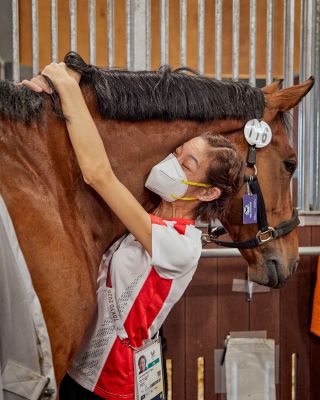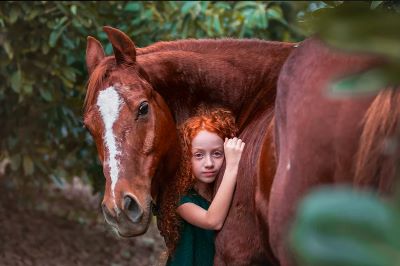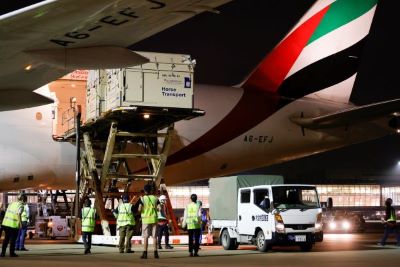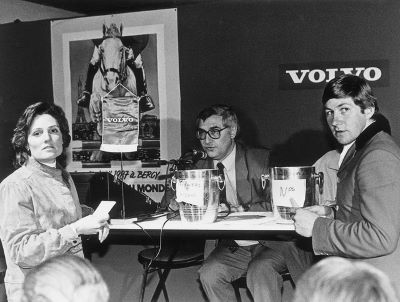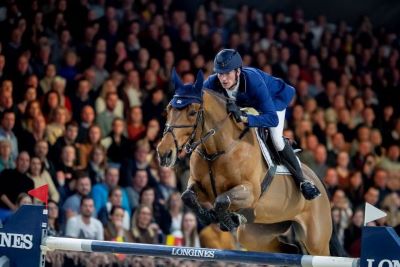At the draw for the FEI Jumping World Cup™ Final in Paris in 1987 (L to R): Leslie Burr-Lenehan (USA), World Cup Director Max E Ammann, and Nick Skelton (GBR). (FEI Archive)
As the FEI celebrates its centenary, one man’s name stands out when it comes to the development of equestrian sport over the last 100 Years – journalist, historian, art collector, and creator of the FEI World Cup™ Jumping series, Mr. Max Ammann.
There are people who talk, and people who do, and Switzerland’s Max Ammann is very definitely one of the latter. Over a 30-year period from 1978 to 2008, he drove equestrian sport out of a culture of conservative complacency and into an era of energy and progress that has brought us to where we are today.
He didn’t do it alone. He had the support of the three FEI Presidents of his era, and in particular the late Prince Philip who championed many of his innovative ideas.
And the story began in the fishing, farming, and wine growing lakeside village of Ermatingen in Switzerland where his father kept horses on the family farm.
Two businesses
“For over 100 years our family had two businesses. One was local transport and the other was buying fruit and vegetables from farmers and delivering to big shops in Zurich and St Gallen. So we had five horses, and in 1945 my father decided to compete with them. At that time, we had Driving competitions on a local and national level, and he competed from 1946 until 1955. He was quite successful and I was his groom,” Max says.
That led to father and son travelling to many big horse shows over the following years, and when Max moved to New York in 1964 as Foreign Correspondent for Swiss, German, and Austrian newspapers he decided to drop in on the National Horse Show which, at the time, was staged in Madison Square Garden. “I met a lot of people including Bill Steinkraus, Frank Chapot, Kathy Kusner, and Bert de Nemethy. So I started writing about horses and horse shows for (Swiss magazines) Cavallo and Reiter Revue and (American publication) Chronicle of the Horse,” he explains.
He returned to Europe for the FEI World Championships in Jumping at La Baule (FRA) in 1970 and the Olympic Games in Munich (GER) in 1972, and then in 1973 relocated to Switzerland once again when taking up the job of Chief Editor at Luzerner Tagblatt, the daily newspaper in Lucerne.
Agreement
“I had an agreement that I would go to 10 or 15 horses shows every year, so I started with the CSIOs, which were the dominant events at the time, and then began going to indoor shows which were practically unknown. I was the only foreign journalist at s’Hertogenbosch (NED), Amsterdam (NED), Berlin (GER), or Dortmund (GER), but I wrote about the competitions and I could feel that there was something happening in the sport,” Max says.
What he was feeling was the change of mood brought about by the success of those World Championships in La Baule. The 1960s had been very difficult.
“Most international events in showjumping were held outside Europe at the time. The ’64 Olympics were in Tokyo (JPN), in ’68 they were in Montreal (CAN), and in ’66 the World Championships in Jumping were in Argentina. Also that year the big Swamp Fever (Equine Infectious Anaemia) crisis happened, and as a result no continental Europeans competed at the Eventing World Championships in Burghley (GBR) and no Irish or British competed at the European Jumping Championships in Lucerne (SUI).”
Change for the better
But there was a major change for the better in the 1970s in a number of different ways. Jumping grew in popularity after the thrilling World Championships at La Baule in 1970 and the size and scale of the Munich Olympic Games in 1972, which will forever be remembered for the devastating terrorist attack, but which were also the largest yet, setting records in all categories with 195 events and 7,134 athletes from 121 National Olympic Committees.
That led to a coming together of journalists and riders alike, and during the FEI World Championships at Hickstead (GBR) in 1974 the International Alliance of Equestrian Journalists was formed.
The riders then decided they wanted the same kind of representative body, and at a meeting in Geneva in 1977 they established the International Jumping Riders Club of which Max was Secretary for a few years.
With the sport clearly moving in a more positive direction, TV broadcasters became increasingly interested in it. “When we were in Aachen or Hickstead we went to dinner together each evening and of course we talked a lot. We discussed the binding together of shows to create more interest, and that’s how the World Cup idea was born,” Max says.
Indoor shows became the main focus, and originally the plan was to create a Formula 1 motor-racing-style series, “in other words one worldwide tour.” However, Bill Steinkraus felt it was too complicated, in part due to the cost and stress of transporting horses all round the world. So the League system, that still remains to this day, was considered.
Presented
In 1978 Max presented the idea to then FEI Secretary General Fritz Widmer who advised him to take it to a Jumping Committee meeting in Brussels, Belgium where the FEI had its headquarters at the time. They liked it and made a favourable report to FEI President, the late Prince Philip, who invited Max to Windsor to discuss it.
“I had already written the rules and he liked it very much and said two things – ‘First, if we do it, then you have to run it!’ and ‘Now I’m going to translate it from American English into proper English!’”
Then there was the question of who should pay for it. Max spoke with Mark McCormack, manager and founder of IMG group which managed top sports figures and celebrities, but they weren’t interested, instead offering to sign up the world’s top riders. When that didn’t materialise, Max turned to an old friend, former Olympic rider Anders Gernandt, who was now a commentator on Swedish TV. And that was the turning point in the story.
“He put me together with the President of Volvo, Pehr Gyllenhammar, who invited me to dinner with a group including his friend Ulf Bergqvist, a Director of a bank and the Director of the Scandinavium Arena in Gothenburg. They listened to my presentation and I said I’d need 480,000 Swiss Francs which at the time was quite some money! After dinner we sat down and had some Cognac, and Gyllenhammar put out his hand and said, ‘It’s a deal!’ So now I had the agreement of Prince Philip and the President of Volvo and that was sufficient,” Max says.
Concept
So what was it about the concept of the Jumping World Cup that they found so appealing?
“I think it just had to come. I’m not a gambler; I only take calculated risks and I was absolutely sure it would succeed because there were precedents in skiing and football and other sports. And in the meantime, I had talked to many horse shows in New York, Washington, to Gene Mische in Florida, to people in Toronto, Berlin, Dortmund, and Vienna and they were all interested.”
And where did Max get the confidence and skills to put it all together?
“I come from a little village on Lake Constance, and my father had a business so the logical thing when I left Secondary School was to make an apprenticeship in business. So I worked with an international transport company and travelled all around Europe for five years learning the job. Then I worked in shipping companies in Hamburg and Basel, so I had a business education before I switched to journalism in the early 60s. I knew how to make an offer, how to write letters, how to calculate, how to read figures in an annual report, and I spoke English, French, and German and all of that helped,” he explains.
In an obituary after the death of Prince Philip, Max wrote that when HRH was elected FEI President in 1964, words like sponsorship, communications, doping control, marketing and public relations were unknown at the FEI. “It was Prince Philip who brought the FEI forward; he was a visionary but also a very practical man,” he says.
FEI
Max left his job at Luzerner Tagblatt and, with a contract created by the Prince, worked from FEI HQ when it moved from Brussels to Berne. And as the years rolled on, he was involved in the early stages of the creation of the Dressage and Driving World Cups which were based on similar lines.
“The Dressage people became jealous of the Jumpers because they were getting a lot more media attention and there was a lot of discussion about how the Dressage World Cup should be, including some wild ideas. Prince Philip was annoyed by some of the proposals made at a Board meeting, so he told the Dressage Committee to sit with me to sort it out and I told them ‘Gentlemen, I don’t know anything about Dressage or how to develop or promote it, but I can help sell it!’ And a member of the Dressage Committee saved it when suggesting we have a Grand Prix with the best going into the Kur which is the World Cup competition. So through the Grand Prix you preserve the tradition of Dressage and with the Kur you have what people like to see!”
The next discipline that wanted a World Cup was Eventing. “At the Olympics in Seoul in ’88, the Americans wanted it and Roger Haller came to me asking for help to make it happen. Princess Anne was then President and I discussed it with her, but she rightly thought it would be too difficult because Eventing horses don’t compete every week, so nothing came of it,” Max says. However, the FEI Driving World Cup would become a reality.
Seminar
At the FEI Driving World Championships in Hungary in 1989, Max heard the Driving Committee discussing the details of a seminar the following day. “I said to them, what you are talking about is of no importance for the future of the sport; you need to discuss finance, how to create interest, and how to get journalists to cover the sport!”
The following morning, he got a call from Committee President Jack Pemberton asking him to address the seminar, and it went so well he was invited to create an ad hoc Committee of which he would be Chairman. Instead of inviting insiders, however, Max opted to bring in non-specialists including the marketing manager of the Winter Olympics and, after two meetings, they put a proposal to a seminar in Wolfsburg in 2002. Not everyone was initially impressed by the new formula, but a week later the organisers at Aachen expressed an interest and the series began in earnest a year later.
In the lead-in, however, and much to Max’s amusement, a test-run in Gothenburg didn’t meet with everyone’s approval. “I invited all the World Champions of the previous 20 years and they were allowed to train from 11pm to midnight before their event. It was their first experience at a big indoor show, so they drove like maniacs for an hour! Olaf Petersen was course building for the Jumping World Cup and he came racing into my office the following morning and shouted, ‘It looks like a battlefield out there; don’t let those mad Drivers in my arena again!'” Max relates with a laugh.
The FEI Driving World Cup™ survived, however, and went on to become another major success.
Overview
Max’s involvement in equestrianism has given him a great overview. He’s passionate about recording the history of the sport and the two books he wrote for the FEI – “Equestrian Sport in the Olympic Games” and “The History of the FEI Championships” – have become a valued resource.
Looking back on that history, he recalls that not everyone played by the rules down the years. He talks about the Nations Cups staged in Harrisburg, Washington, New York, and Toronto where they ran the classes with just three team-members instead of four, “because they felt four riders with one drop-score was too complicated.” And they broke the rules even further when permitting women onto those teams.
“In the summer of 1950 they had trials for New York and Toronto, and the three riders who qualified were Arthur McCashin, Norma Matthews, and Carol Durant, even though, officially, women were not allowed to compete in Nations Cups at the time – but I think the FEI were half-asleep in Brussels!” Max says with a chuckle.
Talking about his relationship with the three Presidents of his era, he describes Prince Philip as “the best the FEI ever had, an absolute leader and a thinker.” Max learned that HRH didn’t always mean what he said, however.
“He had his specialities when you talked with him. When he said ‘I see,’ he didn’t see at all, so you had to explain more. And when he said ‘I don’t understand,’ you knew he understood perfectly well, but didn’t like what you just said!”
Men’s Club
Max constantly describes the FEI as “a Men’s Club” during those years, and says when Prince Philip’s daughter, Princess Anne, took over the Presidential role, she did a great job but had a much tougher time than her father, simply because she was a woman.
HRH the Infanta Doña Pilar de Borbon was also a good President. “She had a less competitive background than Anne, who was an Olympian and a European champion and was from a horse family. But Doña Pilar loved horses and worked very hard at the FEI,” Max says.
Back on the subject of three-rider Nations Cup Jumping teams, Max says he’s a big advocate of the formula which will be used at this summer’s Olympic Games in Tokyo. “Because we have to make our sport understood by the ordinary people, not just the specialists,” he says earnestly. “I sat for 30 years in press stands at Aachen and Rome and even there you have to watch and make calculations, and that shouldn’t be necessary.”
Reasoning
“I understand the reasoning of riders and Chefs because of course it’s nice to give young riders their first experience and share the responsibility more. But you could do that by having three riders in Superleague teams and allow the lower developing level teams to have four,” he says.
And what if the three-rider format produces strange results? “Well, that’s sport, and sport doesn’t produce justice; it produces winners!” he insists.
Max retired from the FEI in 2008 but he never sits still. As editor of L’Annee Hippique for 30 years, during which time he also produced “about 30” Media Guides and two books on the World Cup, he has continued writing and recently published an extensive history of the Swiss Equestrian Federation. As an art collector and art lover, he is involved in the work of the Foundation for Naive and Outsider Art in St Gallen, which supports lesser-known artists who are “not in the mainstream.”
Speaking about the philosophy behind his successful career, Max says it was built on engaging everyone in conversations, and on his belief that “you shouldn’t hide and you shouldn’t lie! When you make decisions, you have to stand over them and be prepared to explain why you made them.”
Max Ammann made a lot of good ones, and equestrian sport today owes him a great debt of gratitude.
By Louise Parkes
Media contact:
Shannon Gibbons
Media Relations and Communications Manager
shannon.gibbons@fei.org
+41 78 750 61 46
